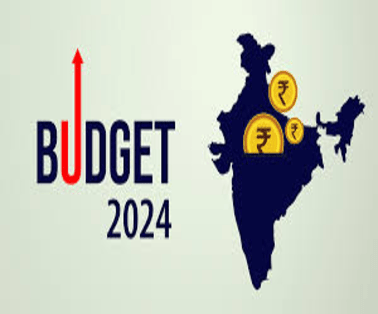The interim Budget, a ‘stop-gap’ arrangement, was presented by Union Finance Minister of India Smt Nirmala Sitharaman on February 1 as a full Budget will be presented in June-July.
Key Points of the Union Budget
- The Union Budget is also known as the Annual Financial Statement.
- Article 112 of the Constitution of India lays down that it is a statement of the estimated expenditure and receipts of the Government for a particular year.
- The Budget keeps the account of the finances of the government for the fiscal year (from 1st April to 31st March).
- The Budget is presented on 1st February (until 2016, it was presented on the last working day of February) so that it can materialise before the commencement of the new financial year which starts on 1st April.
- In 2017, a 92-year-old tradition was broken when the railway budget was merged with the Union Budget and presented together.
- The Budget has to be passed by the Lok Sabha before it can come into effect.
- The Union Budget is divided into Revenue Budget and Capital Budget.
- In the Union Budget, the disbursements and receipts of the government comprise the various types of government funds in India namely, the Consolidated Fund of India, the Contingency Fund and the Public Account.
What is Interim Budget?
It is a shorter-term financial statement that allows for the smooth functioning of the government until a new administration can present a full budget for the entire fiscal year.
In an election year, the incumbent Government cannot present a full Budget as there may be a change in the executive.
The interim budget includes documentation of expenses until the upcoming elections are held, whereas a regular budget includes estimates of expenditure for the full year.
Also generally, major policy changes are not announced in the interim budget.
An outgoing government presents only an interim Budget or seeks a vote on account.
An Interim Budget is not the same as a ‘Vote on Account’. While a ‘Vote on Account’ deals only with the expenditure side of the government’s budget, an Interim Budget is a complete set of accounts, including both expenditure and receipts
Key Features of the Interim Budget
Social Justice
- Prime Minister to focus on upliftment of four major castes, that is, ‘Garib’ (Poor), ‘Mahilayen’ (Women), ‘Yuva’ (Youth) and ‘Annadata’(Farmer).
‘Garib Kalyan, Desh ka Kalyan’
- Government assisted 25 crore people out of multi-dimensional poverty in last 10 years.
- DBT of Rs. 34 lakh crore using PM-Jan Dhan accounts led to savings of Rs. 2.7 lakh crore for the Government.
- PM-SVANidhi provided credit assistance to 78 lakh street vendors. 2.3 lakh have received credit for the third time.
Welfare of ‘Annadata’
- PM-KISAN SAMMAN Yojana provided financial assistance to 11.8 crore farmers.
- Under PM Fasal BimaYojana, crop insurance is given to 4 crore farmers
Momentum for Nari Shakti
- 30 crore Mudra Yojana loans given to women entrepreneurs.
- Female enrolment in higher education gone up by 28%.
- In STEM courses, girls and women constitute 43% of enrolment, one of the highest in the world.
- Over 70% houses under PM Awas Yojana given to women from rural areas.
PM Awas Yojana (Grameen)
- Despite COVID challenges, the target of three crore houses under PM Awas Yojana (Grameen) will be achieved soon.
- Two crore more houses to be taken up in the next five years.
Rooftop solarization and muft bijli
- 1 crore households to obtain 300 units free electricity every month through rooftop solarization.
- Each household is expected to save Rs.15000 to Rs.18000 annually.
Ayushman Bharat
- Healthcare cover under Ayushman Bharat scheme to be extended to all ASHA workers, Anganwadi Workers and Helpers.
Agriculture and food processing
- Pradhan Mantri Kisan Sampada Yojana has benefitted 38 lakh farmers and generated 10 lakh employment.
- Pradhan Mantri Formalisation of Micro Food Processing Enterprises Yojana has assisted 2.4 lakh SHGs and 60000 individuals with credit linkages.
Research and Innovation for catalyzing growth, employment and development
- A corpus of Rs.1 lakh crore to be established with fifty-year interest free loan to provide long-term financing or refinancing with long tenors and low or nil interest rates.
- A new scheme to be launched for strengthening deep-tech technologies for defence purposes and expediting ‘atmanirbharta’.
Infrastructure
- Capital expenditure outlay for Infrastructure development and employment generation to be increased by 11.1 per cent to Rs.11,11,111 crore, that will be 3.4 per cent of the GDP.
Railways
- 3 major economic railway corridor programmes identified under the PM Gati Shakti to be implemented to improve logistics efficiency and reduce cost
- Energy, mineral and cement corridors, Port connectivity corridors and High traffic density corridors
- Forty thousand normal rail bogies to be converted to Vande Bharat standards.
Aviation Sector
- Number of airports in the country doubled to 149.
Green Energy
- Coal gasification and liquefaction capacity of 100 MT to be set up by 2030.
- Phased mandatory blending of compressed biogas (CBG) in compressed natural gas (CNG) for transport and piped natural gas (PNG) for domestic purposes to be mandated.
Tourism sector
- States to be encouraged to take up comprehensive development of iconic tourist centres including their branding and marketing at global scale.
- Framework for rating of the tourist centres based on quality of facilities and services to be established.
- Long-term interest free loans to be provided to States for financing such development on matching basis.
Investments
- FDI inflow during 2014-23 of USD 596 billion was twice of the inflow during 2005-14.
Reforms in the States for ‘Viksit Bharat’
- A provision of Rs.75,000 crore rupees as fifty-year interest free loan is proposed to support milestone-linked reforms by the State Governments.
Revised Estimates (RE) 2023-24
- RE of the total receipts other than borrowings is Rs.27.56 lakh crore, of which the tax receipts are Rs.23.24 lakh crore.
- RE of the total expenditure is Rs.44.90 lakh crore.
- Revenue receipts at Rs.30.03 lakh crore are expected to be higher than the Budget Estimate, reflecting strong growth momentum and formalization in the economy.
- RE of the fiscal deficit is 5.8 per cent of GDP for 2023-24.
Budget Estimates 2024-25
- Total receipts other than borrowings and the total expenditure are estimated at Rs.30.80 and Rs.47.66 lakh crore respectively.
- Tax receipts are estimated at Rs.26.02 lakh crore.
- Scheme of fifty-year interest free loan for capital expenditure to states to be continued this year with total outlay of Rs.1.3 lakh crore.
- Fiscal deficit in 2024-25 is estimated to be 5.1 per cent of GDP
- Gross and net market borrowings through dated securities during 2024-25 are estimated at Rs.14.13 and Rs.11.75 lakh crore respectively.
Direct taxes
- FM proposes to retain same tax rates for direct taxes
- Direct tax collection tripled, return filers increased to 2.4 times, in the last 10 years
- Tax benefits to Start-Ups, investments made by Sovereign wealth funds or pension funds extended to 31.03.2025
- Tax exemption on certain income of IFSC units extended by a year to 31.03.2025 from 31.03.2024
Indirect taxes
- FM proposes to retain same tax rates for indirect taxes and import duties
- GST unified the highly fragmented indirect tax regime in India
Tax rationalization efforts over the years
- No tax liability for income upto Rs 7 lakh, up from Rs 2.2 lakh in FY 2013-14
- Presumptive taxation threshold for retail businesses increased to Rs 3 crore from Rs 2 crore
- Presumptive taxation threshold for professionals increased to Rs 75 lakh from Rs 50 lakh
- Corporate income tax decreased to 22% from 30% for existing domestic companies
- Corporate income tax rate at 15% for new manufacturing companies
Achievements in tax-payer services
- Average processing time of tax returns has reduced to 10 days from 93 days in 2013-14
- Faceless Assessment and Appeal introduced for greater efficiency
- Updated income tax returns, new form 26AS and prefilled tax returns for simplified return filing
Conclusion
The Interim Budget 2024 has laid the groundwork for continued growth and stability in India’s economy, particularly focusing on social justice, agriculture, and infrastructure. While it doesn’t introduce major policy changes, it ensures that government operations proceed smoothly until the full Union Budget is presented later in the year.
To Download Monthly Current Affairs PDF Click here
Click here to get a free demo
Everything About CLAT 2026



